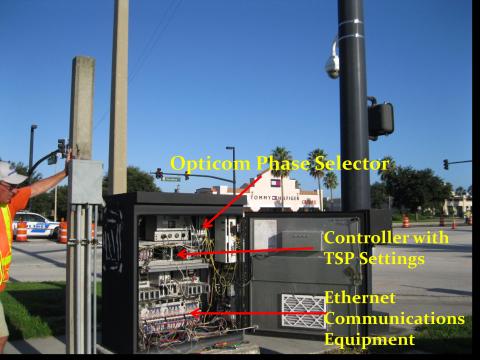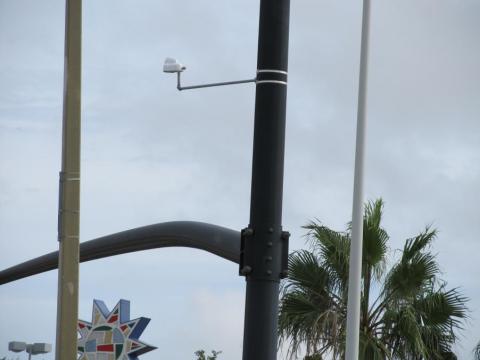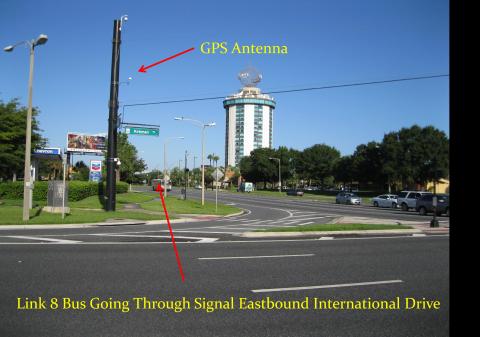Performance Measurements of Transportation Systems based on Fine-Grained Data Collected by AVI and AVL Systems
Performance measurement is an important component of the planning and operation of transportation systems. Reflecting the increasing realization of this importance, the Map-21 legislation has put a very strong emphasis on performance measurements, requiring states and local agencies to establish and achieve performance targets. Point traffic detectors have been deployed along freeway facilities, providing mainly measurements of speed, volume, and occupancy. Automatic Vehicle Identification (AVI) technologies have also been increasingly implemented to directly collect travel time information rather than estimating them based on point measurements by traffic detectors. Transit agencies have used Automatic Vehicle Location (AVL) location technology to measure and manage the performance of their Fleets. The goal of this project is to investigate the opportunities for more detailed and accurate performance measurements of transportation systems based on point detectors, AVI, and AVL data.
The project has examined free-flow speeds and their distributions along three corridors, including two freeway corridors (I-95 and Florida Turnpike) and one arterial street (US-1). The free-flow speeds for the I-95 corridor and US-1 were estimated based on the detector data and Bluetooth data, while the free-flow speeds along the Florida Turnpike were I-95 and US-1 were estimated from the detector and toll tag data due to the data availability. The K-S tests were conducted to test the normality of free-flow speed distribution and also test if two free-flow sequences come from the same distribution.
The differences between travel time estimates from detector data and AVI data (including Bluetooth data and electronic toll data) under different traffic conditions and different route lengths were examined in this project. Also, in order to determine the accuracy of disseminated instantaneous travel time information and thus the potential benefits of utilizing predictive travel time modeling, this study investigated the difference between instantaneous travel time and experienced travel time.
Various methods were developed in this project to estimate queue length and density, including methods that are only based on traffic detector data, or only based on AVI data, or combination of different data sources. The developed methods were applied to the roadway segment along the Florida Turnpike using real-world data. Meanwhile, a micro simulation model along the SR-826 was conducted to assess the estimation accuracy of each method.
At the same time, the project is evaluating Transit Signal Priority (TSP) based on AVL data. The main goal of this research part of the project is to evaluate the benefits of TSP on transit operations in terms of: Improvement in bus travel time through International Drive (I-Drive), a real life corridor in Orlando, Florida, and bus adherence to schedule by reducing its travel time variability. Furthermore, this research will explore reduction in bus emissions which is expected to increase environmental sustainability. The research team has collected traffic data in the above corridor, and also collected “Before” and “After” TSP on-board bus data and reviewed signal pre-emption logs to determine if conditional TSP improves transit schedule reliability and adherence. The “Before” and “After” study has been completed. Statistical analysis and comparisons between “Before” and “After” conditions have been evaluated. The TSP effectiveness has also been evaluated using VISSIM simulation. Sensitivity analysis has been conducted using VISSIM. Several scenarios have been tested to optimize the amount of bus travel time delay while TSP is activated. Signal operations and effect on crossing streets have been evaluated to determine that there is no deterioration in operations for crossing street traffic while TSP is activated.
This research is expected to have important impact on bus patrons of a real world transit corridor. With the help of TSP implementation in this high tourist corridor, it will be determined in future years if TSP can increase bur ridership due to improvement in level of service, and if it can increase environmental sustainability by reducing bus.
Final Report
Presentations:
- "Applications of Traffic Signal Priority Technology for Transit Service", presented at the 2013 UTC Conference for the Southeastern Region in Orlando, Florida, April 4-5, 2013.
- "Comparison of Instantaneous and Experienced Travel Time Using Point Detector Data and AVI Data", presented at the 93rd Annual Meeting of the Transportation Research Board in Washington, D.C., January 12-14, 2014.
- "Estimation of Freeway Density Based on the Combination of Point Traffic Detector Data and Automatic Vehicle Identification Data", presented at the 2015 UTC Conference for the Southeastern Region in Birmingham, Alabama, March 26-27, 2015.
- "Estimation of Freeway Density Based on the Combination of Point Traffic Detector Data and Automatic Vehicle Identification Data", presented at the 94th Annual Meeting of the Transportation Research Board in Washington, D.C., January 11-15, 2015.
- "Evaluating the Environmental Effects of Transit Signal Priority System: A Case Study in State of Florida", presented at the 2nd Transportation and Development Institute Congress in Orlando, Florida, June 8-11, 2014.
- "Evaluation of Conditional Transit Signal Priority Technology for Regional Implementation", presented at the 94th Annual Meeting of the Transportation Research Board in Washington, D.C., January 11-15, 2015.
- "Identifying risk factors for urban expressway traffic crashes using Multi-level Bayesian models with unprocessed Automatic Vehicle Identification data", presented at the 93rd Annual Meeting of the Transportation Research Board in Washington, D.C., January 12-14, 2014.
- "Queue Length Estimation Based on Point Traffic Detector Data and Automatic Vehicle Identification Data", presented at the 2014 UTC Conference for the Southeastern Region in Atlanta, Georgia, March 24-25, 2014.
- "Performance Measurements of Transportation Systems based on Fine-Grained Data Collected by AVI and AVL Systems", presented at the 2013 UTC Conference for the Southeastern Region in Orlando, Florida, April 4-5, 2013.
Project Information Forms:
Publications:
- Consoli, F., Alomari, A., AL-DEEK, H., Rogers, J., Sandt, A., Tatari, O., and Hadi, M. “Applications of Transit Signal Priority Technology for Transit Service to Create A More Sustainable Component of the Transportation System,” paper prepared to be submitted to the International Journal of Sustainable Transportation.
- Consoli, F. , Alomari, A. , AL-DEEK, H., Rogers, J., Sandt, A., Noori, M.,Tatari, O., and Hadi, M. “Evaluation of Conditional Transit Signal Priority Technology for Regional Implementation,” published in the Transportation Research Board 94th Annual Meeting Compendium of Papers CD-ROM, Washington D.C., January 11-15, 2015.
- Consoli, F. , Alomari, A. , AL-DEEK, H., Rogers, J., Sandt, A., Noori, M.,Tatari, O., and Hadi, M. “Evaluation of Conditional Transit Signal Priority Technology for Regional Implementation,” accepted for publication in the Journal of the Transportation Research Board, February 2015.
- Fakharian, S., Xiao, Y., Hadi, M., and AL-DEEK, H., “Estimation of Freeway Density Based on the Combination of Point Traffic Detector Data and Automatic Vehicle Identification Data,” accepted for publication in the Transportation Research Record: Journal of the Transportation Research Board, February 2015.
- Fakharian, S., Xiao, Y., Hadi, M., and AL-DEEK, H., “Estimation of Freeway Density Based on the Combination of Point Traffic Detector Data and Automatic Vehicle Identification Data,” published in the Transportation Research Board 94th Annual Meeting Compendium of Papers CD-ROM, Washington D.C., January 11-15, 2015.
- "Volume-I- Applications of Transit Signal Priority Technology for Transit Service.” Final report, submitted June 30, 2014.
- Xiao, Y., Fakharian, S., Hadi, M., and AL-DEEK, H., “Comparison of Instantaneous and Experienced Travel Time Using Point Detector Data and AVI Data,” accepted for publication in the Journal of the Transportation Research Board, February 2014.
- Xiao, Y., Fakharian, S., Hadi, M., and AL-DEEK, H., “Comparison of Instantaneous and Experienced Travel Time Using Point Detector Data and AVI Data,” published in the Transportation Research Board 93rd Annual Meeting Compendium of Papers CD-ROM, Washington D.C., January 12-16, 2014.
Results will be presented and discussed with FDOT, Lynx, and City of Orlando.
Data exploration was performed from field data collected for each TSP scenario: No TSP, Unconditional TSP, and Conditional TSP with traffic signal red delay and passenger stop delay. Using Data Exploration in the Unconditional TSP, four of the five TSP signals experienced an average delay reduction in the eastbound direction, and three of the signals experienced an average delay reduction in the westbound direction. During Conditional TSP, two of the TSP signals experienced an average delay reduction in the eastbound direction, and three of the signals experienced an average delay reduction in the westbound direction.
Bus trajectories shown in the following two figures is based on the average speed through the corridor showed that both Unconditional and Conditional TSP reduced the average travel time through the segment of the corridor where the TSP signals were concentrated. The eastbound direction experienced a 9.9% travel time reduction during the Unconditional TSP and a 13.7% travel time reduction during Conditional TSP through this corridor segment compared to No TSP. For the same corridor segment, the westbound direction experienced a 9.7% travel time reduction during Unconditional TSP and a 0.2% travel time reduction during Conditional TSP compared to No TSP. Due to small sample size collected in the field, it was necessary to enhance field data analysis with VISSIM simulation model to determine if TSP met the objectives of this project.
Several scenarios were developed utilizing the data collected and information from the City of Orlando to optimize the behind schedule time for the bus. VISSIM was used to model the No TSP, Unconditional TSP, and Conditional TSP with 3 and 5 minutes behind schedule. Compared to the No TSP, Unconditional and Conditional 3 and 5 minutes scenarios showed improved travel time savings. Unconditional TSP showed the greatest travel time savings but issues occurred with theincrease of side street delays when the Unconditional TSP was activated. Conditional TSP 3 minutes was better in travel savings than Conditional TSP 5 minutes for both east and westbound travel directions.
We also developed route travel time savings through the VISSIM models. Compared to the No TSP, all three scenarios of Unconditional and Conditional 3 and 5 minutes showed improved travel time savings. nconditional TSP showed the greatest travel time savings but that increased signalized side street delays when the Unconditional TSP was activated. Conditional TSP 3 minutes was better in travel time savings than Conditional TSP 5 minutes for both east and westbound. Based on our research we can conclude that TSP was beneficial for transit operations in the I-Drive corridor under study by ensuring that buses behind schedule are granted signal priority. This contributes to a better adherence to the bus schedule and increases transit reliability. It was also possible to provide a better understanding of how TSP effects change with different traffic conditions.
Using VISSIM simulation runs, it was possible to model the overall impacts of the TSP system on the local traffic network and effects on side street signal delay. This showed that Conditional TSP with 3 minutes behind schedule did not adversely affect the signalized side streets as this Conditional priority improved the operations of I-Drive. It also showed that the average number of stops were reduced using Conditional TSP when compared to No TSP. Presumably fewer vehicles stopping will represent a smoother traffic flow and less risk of vehicle to vehicle crashes.
Testing TSP while operational in a real world setting is necessary before the TSP system can be expanded beyond the I-Drive corridor. In the era of government budget constraints it is necessary to show that a system will work and can be effective before any expansion can occur.
Expansion of the TSP system without proper testing, modeling and careful evaluation can be a costly endeavor. The agencies responsible for future expansion have to ensure that expansion of the TSP system is cost effective and beneficial to their patrons in reducing travel time and improving schedule reliability. Through our research, it was demonstrated that by reducing bus delay and decreasing travel time, TSP can lead to a more sustainable transportation system. As a component part of the transportation system, TSP is a method to create a more sustainable transportation system by increasing bus efficiency in reducing bus delay and reduction in bus travel times as was shown in this research.
Even though there is no one solution to reduce the transportation contribution to greenhouse gases and global warming, the transportationsector can improve vehicle efficiencies and diversification of transportation options to reduce emissions. A method to reduce possible vehicle emissions is to develop a more efficient transit system because of TSP. This has the potential to decrease individual vehicle usage, so there could be an improvement to the efficiency of the transit system by increasing ridership. It could also lead to a decrease in greenhouse gases and thus reduce the rate of temperature increases and sea level rise. TSP can be effective in environmental improvements if used on a larger scale throughout the United States and the World.
Both FDOT and LYNX are looking at expanding TSP in several areas including areas surrounding the recent operation of the Sunrail commuter train in Central Florida.
Theme by Danetsoft and Danang Probo Sayekti inspired by Maksimer



